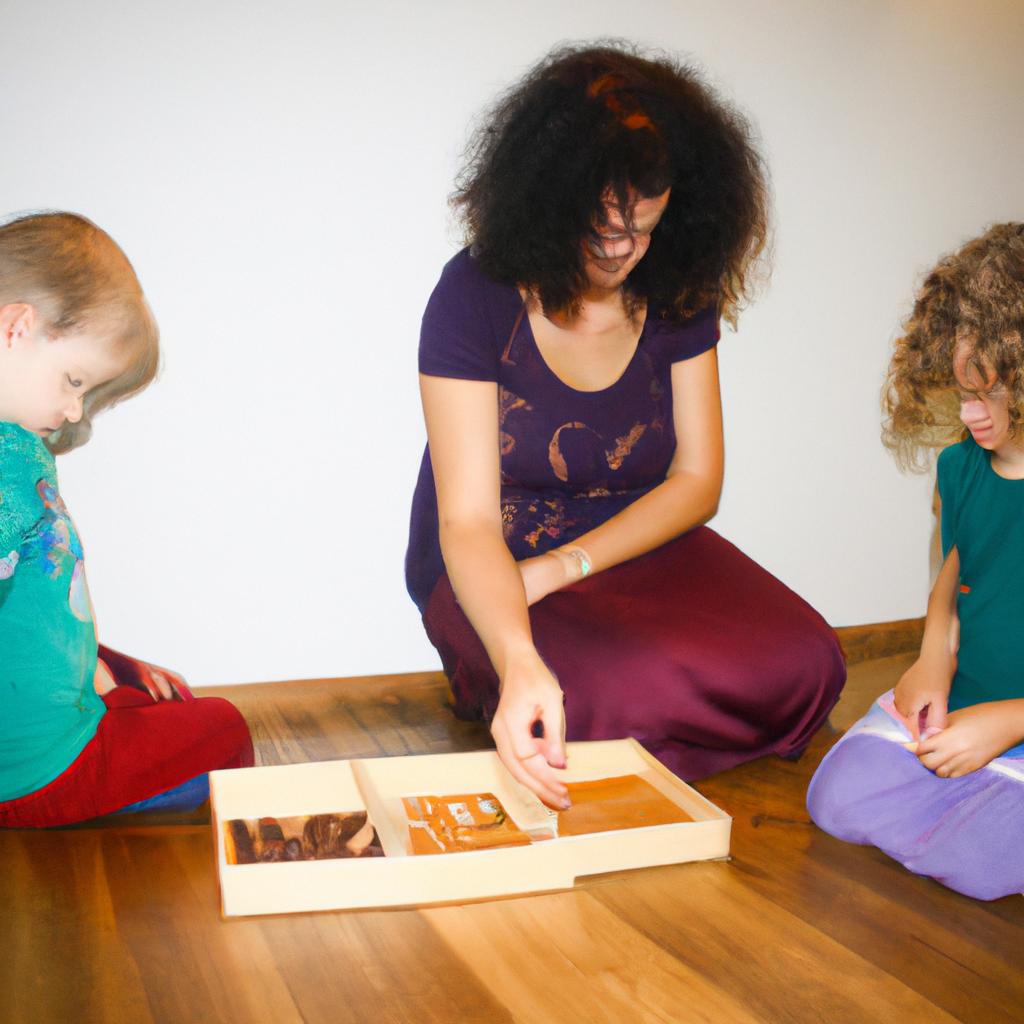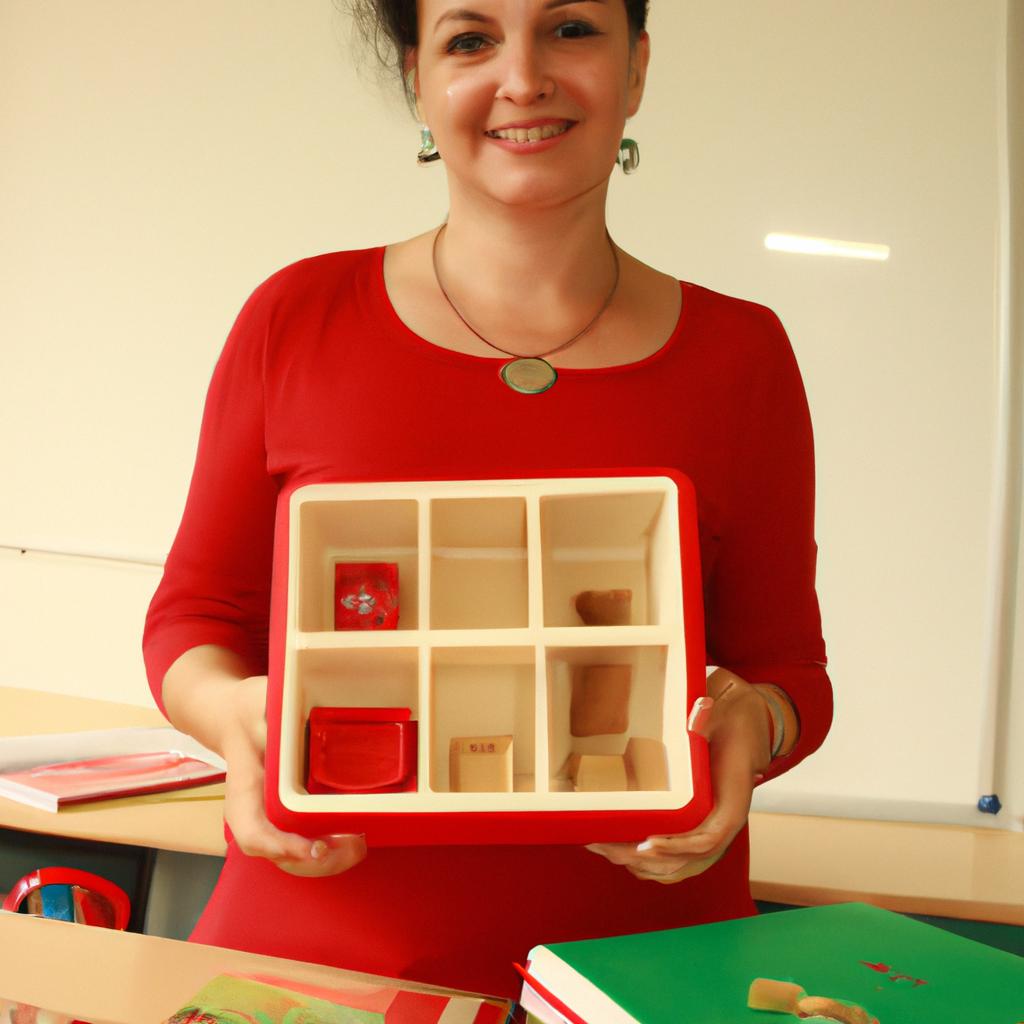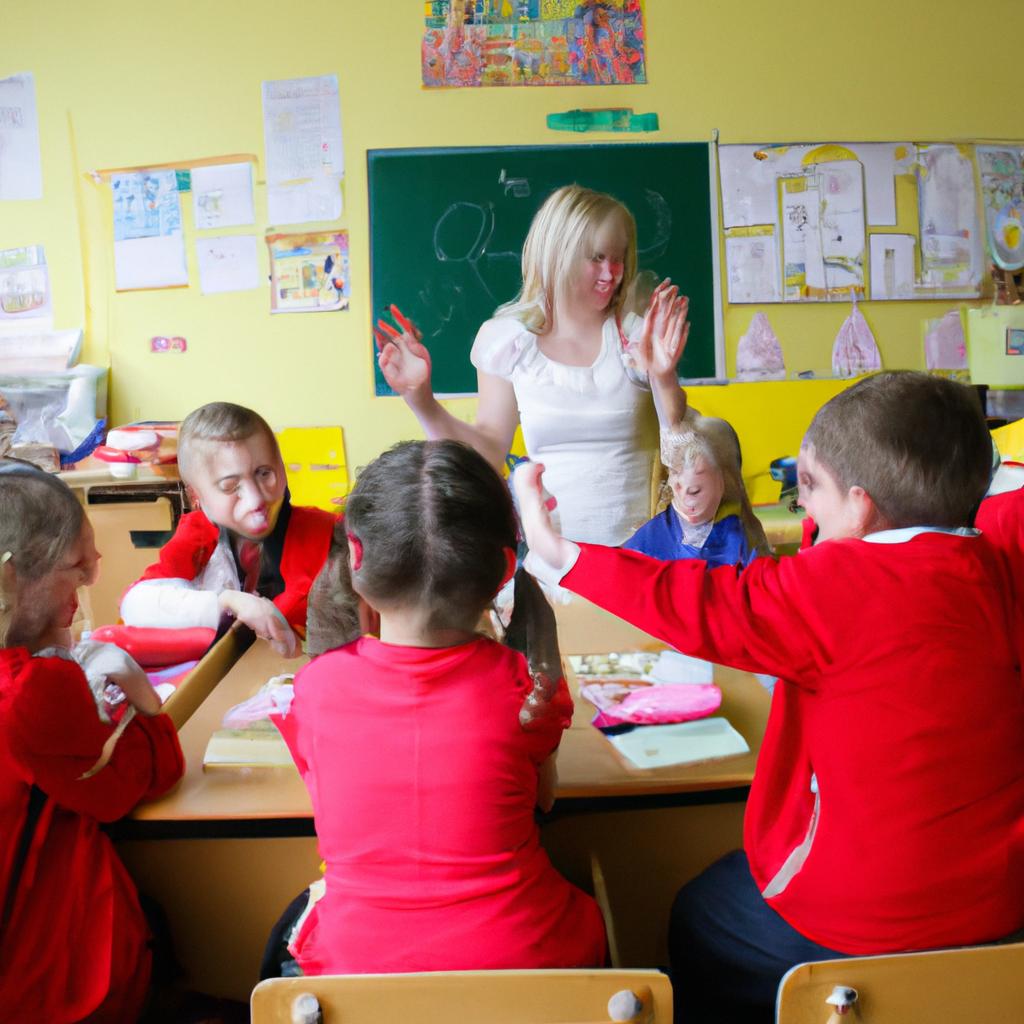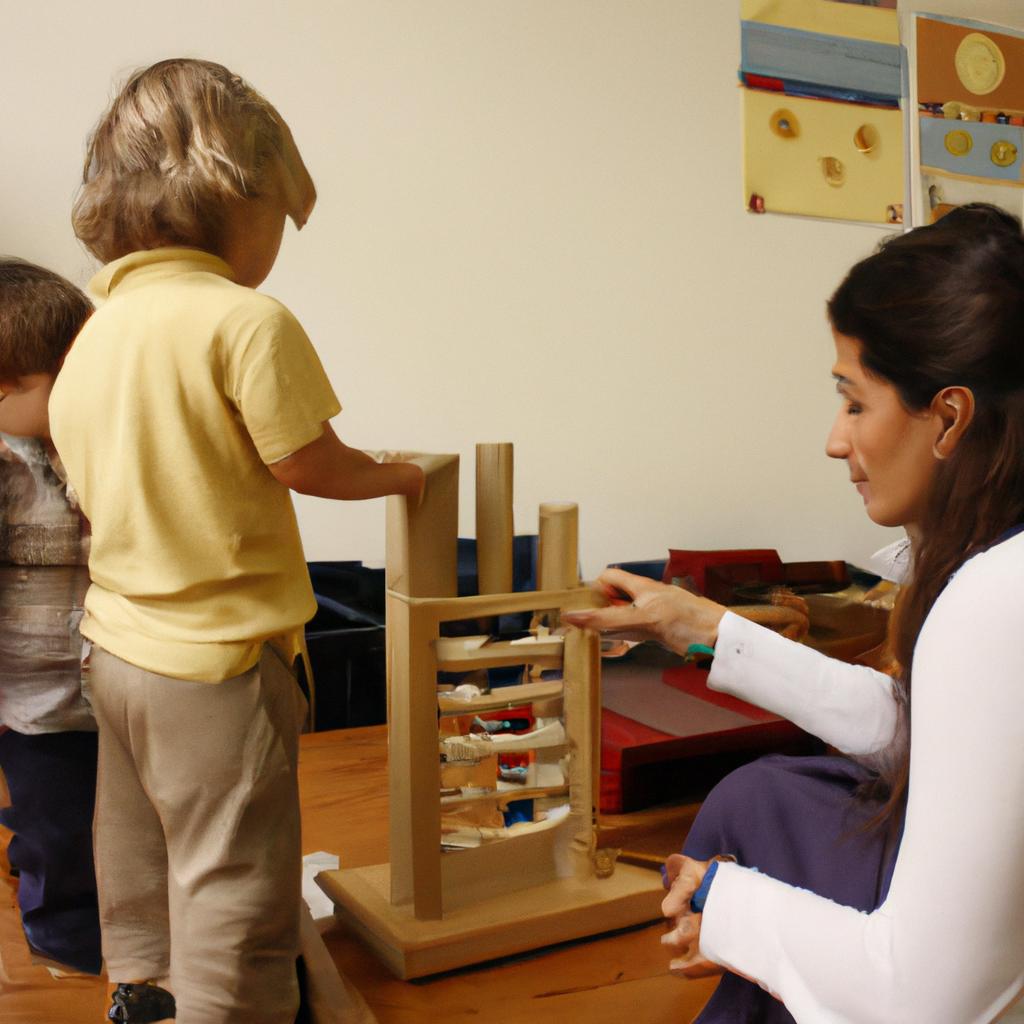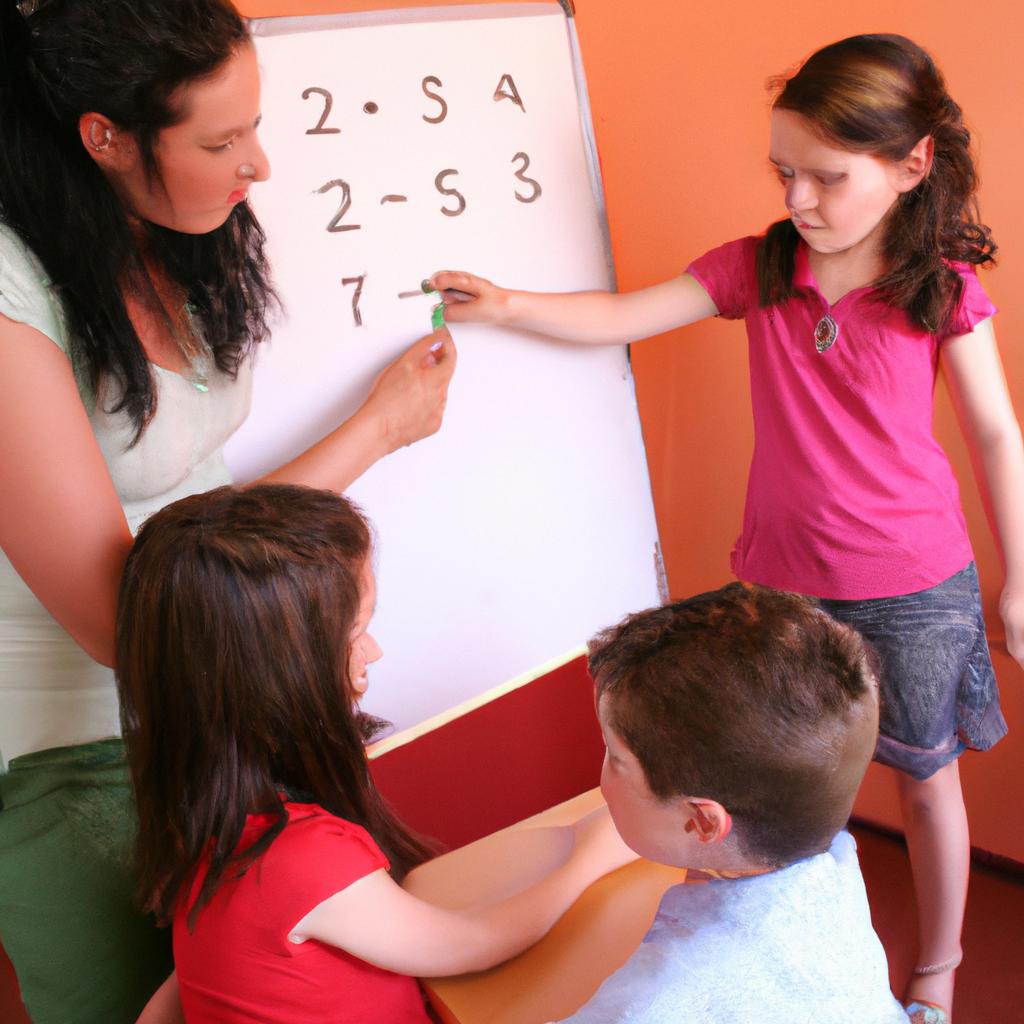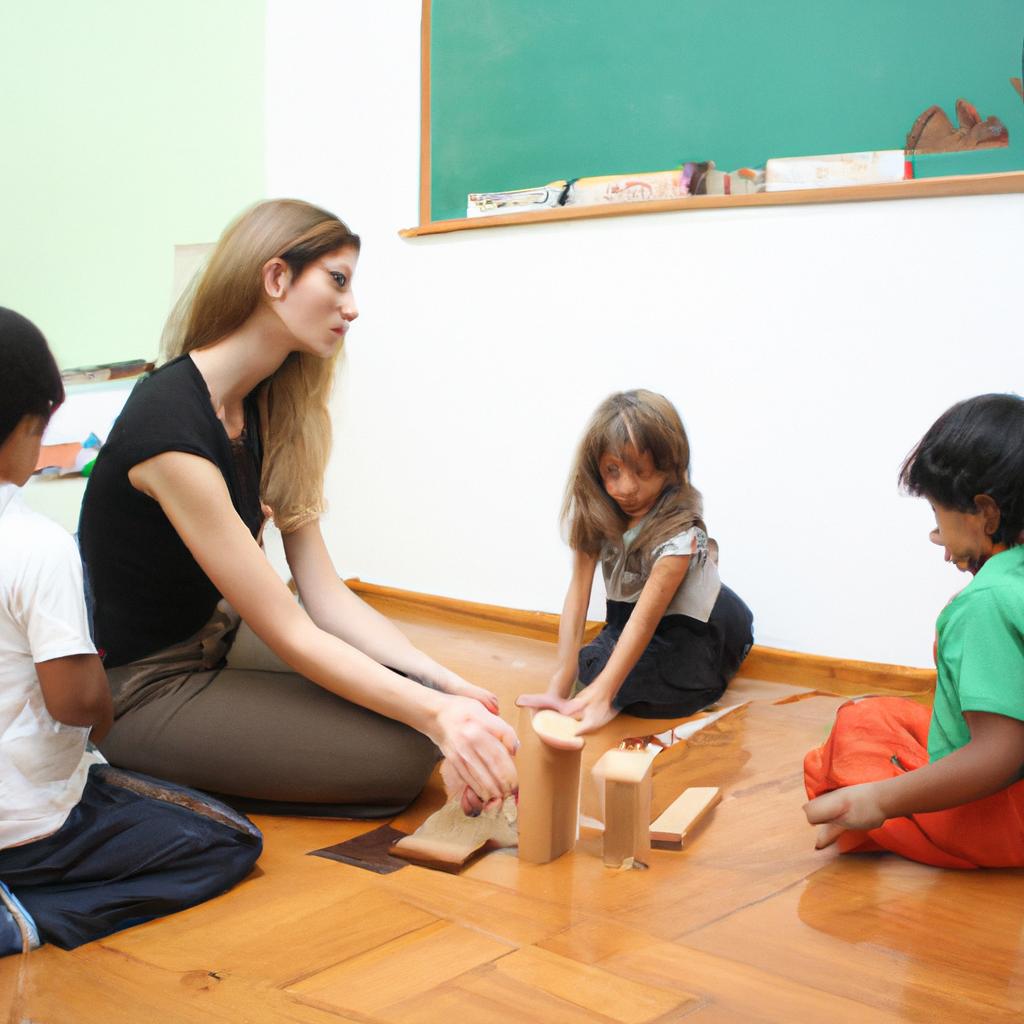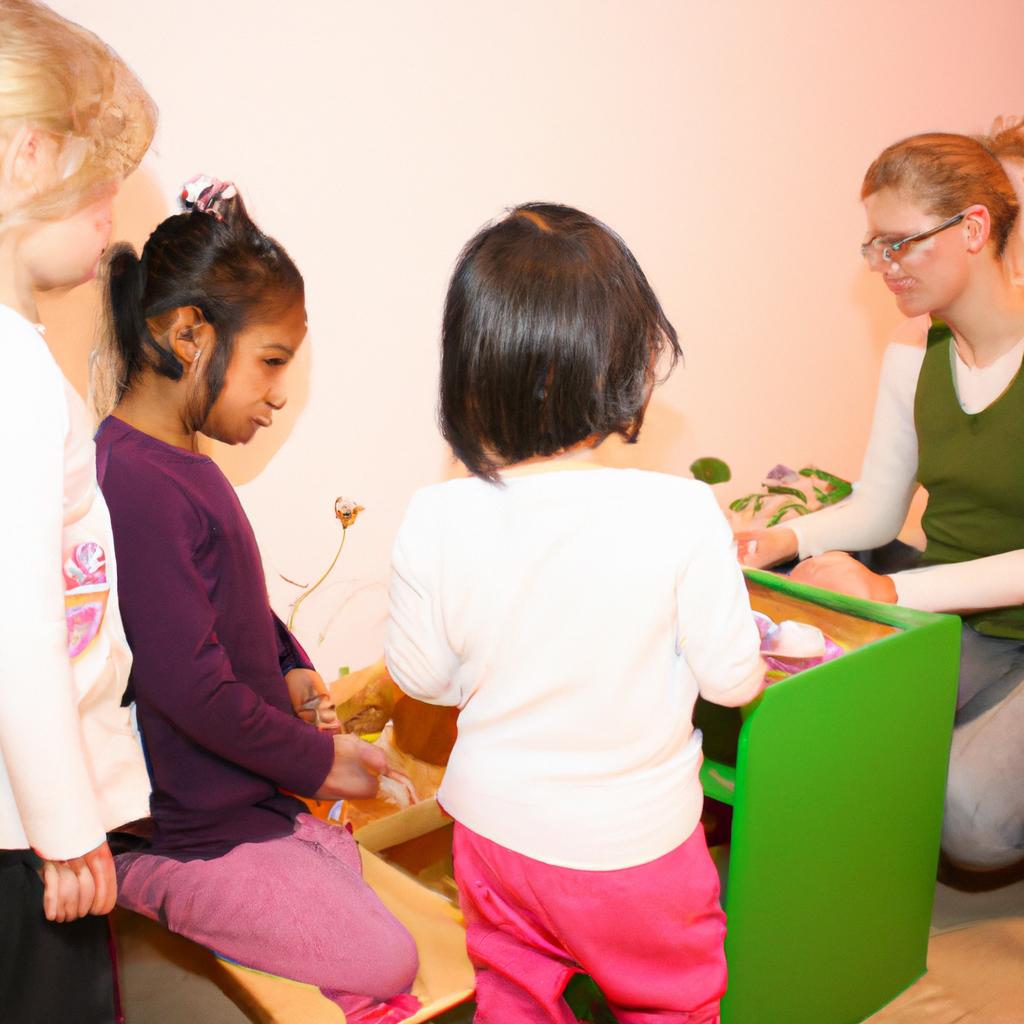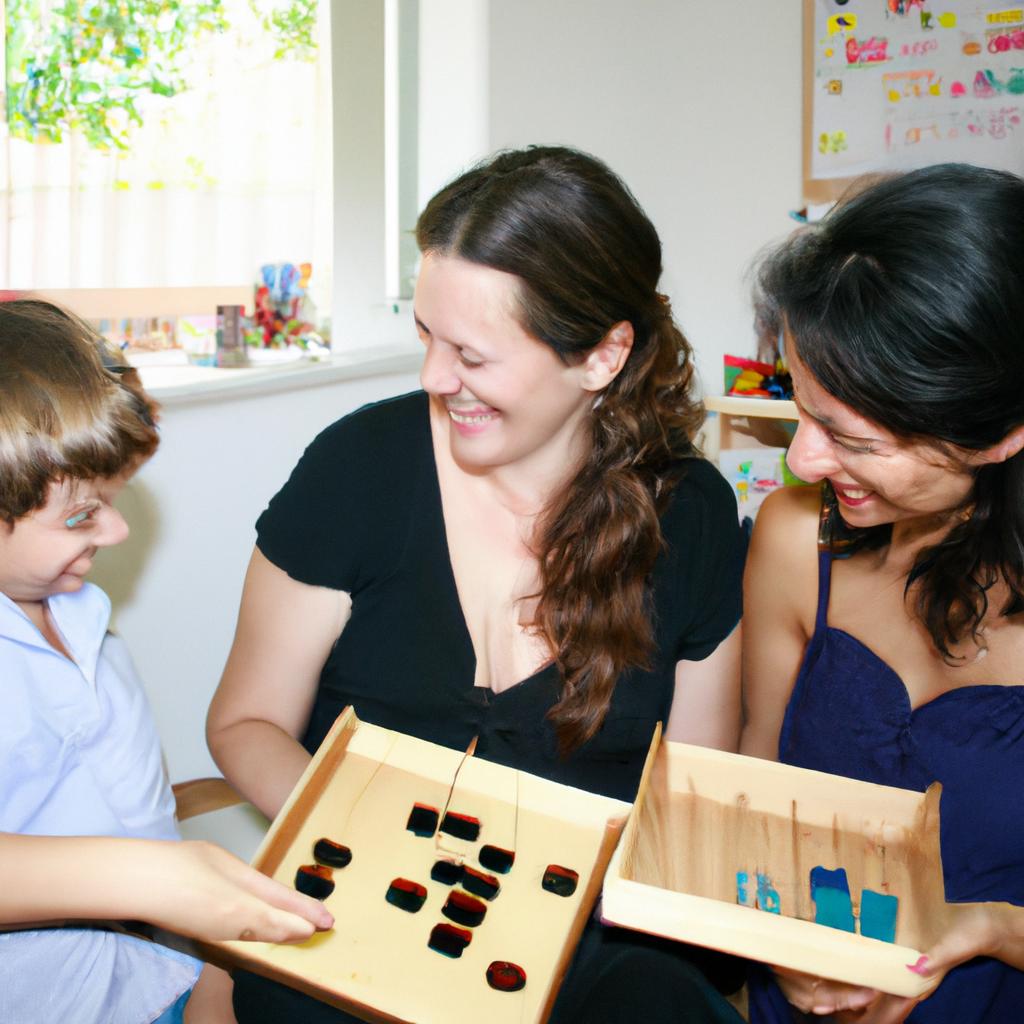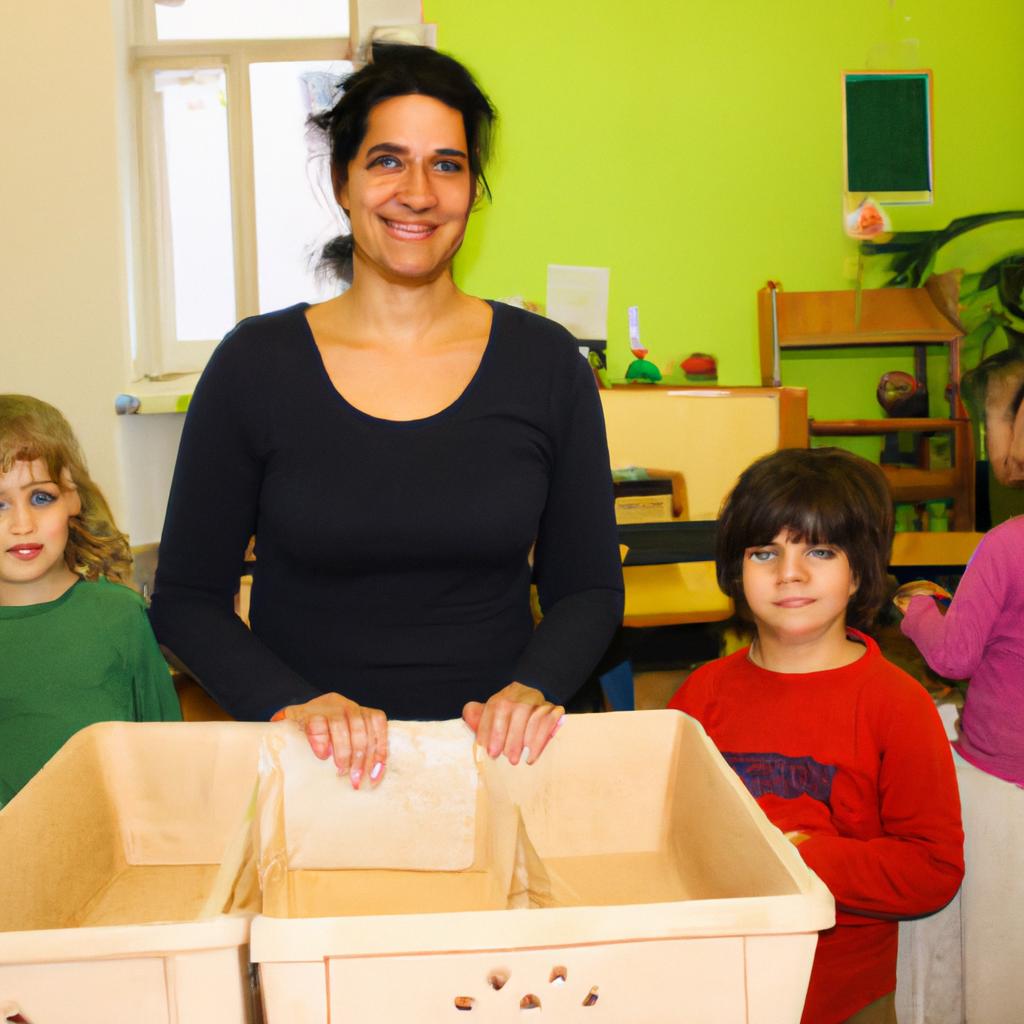Montessori education is renowned for its unique approach to fostering children’s development through a carefully designed curriculum and specialized materials. One area of focus within this educational framework is language development, which plays a pivotal role in cultivating communication skills and building a solid foundation for future academic success. In this article, we will delve into the world of Montessori language materials and explore how they support children’s learning journey.
Imagine a five-year-old child named Emma, who has just entered a Montessori classroom. Unlike traditional classrooms where rote memorization dominates teaching methods, Emma finds herself immersed in an environment brimming with hands-on activities tailored to her needs. Among these resources are specifically designed language materials that aim to engage her senses while nurturing literacy skills. From movable alphabet sets to sandpaper letters, each material serves as a stepping stone towards unlocking the mysteries of written and spoken language. This article aims to shed light on the significance of these meticulously crafted tools and their vital role in facilitating language acquisition and overall cognitive development within the Montessori context.
Importance of Language Materials in Montessori Education
Montessori education places great emphasis on the use of language materials as a vital component of its curriculum. These materials play a crucial role in developing children’s language skills and fostering their overall cognitive growth. For instance, consider the case study of Sarah, a 4-year-old student who struggled with verbal communication when she entered the Montessori classroom. Through consistent exposure to various language materials and carefully guided activities, Sarah gradually improved her vocabulary, pronunciation, and sentence construction abilities. This example demonstrates how effective language materials can facilitate linguistic development in young learners.
The utilization of well-designed language materials offers several benefits within the Montessori educational framework:
- Engagement: Language materials are designed to capture children’s attention and stimulate their interest in learning. They often incorporate attractive visuals or interactive elements that make the process engaging for students.
- Autonomy: Montessori classrooms promote independent learning, and language materials provide opportunities for children to explore language at their own pace. By working independently with these resources, they develop self-confidence and a sense of accomplishment.
- Multisensory Experience: Many language materials engage multiple senses simultaneously – visual (through pictures or illustrations), auditory (through listening exercises), and tactile (by physically manipulating objects). Such multisensory experiences enhance memory retention and understanding.
- Individualized Instruction: The availability of a wide range of language materials allows educators to tailor instruction according to each child’s needs. Teachers can select specific tools based on individual progress levels or areas requiring improvement.
To understand the significance of these points better, let us examine Table 1 below, which showcases some commonly used language materials in Montessori classrooms:
Table 1: Examples of Language Materials Used in Montessori Classrooms
| Material | Purpose | Example |
|---|---|---|
| Sandpaper Letters | Introduction to letter sounds and formation | A child traces the letters with their fingers |
| Movable Alphabet | Practice constructing words and sentences | Children arrange letters to form meaningful words |
| Reading Cards | Enhancing reading skills | Students identify and pronounce different words on cards |
| Grammar Symbols | Introduction to grammatical concepts | Children learn basic sentence structure using symbols |
In conclusion, language materials are fundamental tools in Montessori education due to their ability to engage students, foster independence, provide multisensory experiences, and facilitate individualized instruction. The next section will delve into the various types of language materials commonly used in Montessori classrooms.
Types of Language Materials Used in Montessori Classrooms
Transitioning from the previous section on the importance of language materials in Montessori education, we now turn our attention to exploring the various types of language materials utilized in Montessori classrooms. To illustrate their practical application, let us consider an example where a child named Emily is introduced to these materials.
-
Sandpaper Letters: One type of language material commonly used in Montessori classrooms is sandpaper letters. These are wooden or cardboard cutouts of individual letters covered with sandpaper. Children can trace their fingers along the textured surface while pronouncing the corresponding phonetic sound. For instance, when introduced to the sandpaper letter ‘a,’ Emily feels its roughness and simultaneously hears her teacher say “a” as she traces it with her finger.
-
Moveable Alphabets: Another essential tool for language development in Montessori education is the moveable alphabet. This consists of small movable letters that children can arrange to form words by placing them side by side on a mat or table. Continuing with our example, after becoming familiar with some basic sounds using sandpaper letters, Emily progresses to forming simple three-letter words such as ‘cat’ and ‘dog’ using this interactive material.
-
Language Object Box: In addition to tactile materials like sandpaper letters and moveable alphabets, Montessori classrooms often incorporate language object boxes. These boxes contain objects associated with specific vocabulary words and provide a hands-on approach for enhancing word recognition and comprehension skills. For instance, if Emily comes across the word ‘apple,’ she could reach into a box filled with real apples, experience their texture firsthand, and further solidify her understanding of the written word.
-
Phonics Cards: Lastly, phonics cards play a crucial role in teaching children how different combinations of letters produce unique sounds within words. Typically presented as flashcards featuring images accompanied by corresponding textual labels, they serve as effective visual aids for phonetic instruction. Emily could be shown a card depicting a picture of an umbrella while simultaneously hearing the word being pronounced, thereby linking the visual representation with its respective sound.
These diverse language materials offer engaging and multisensory experiences that facilitate language acquisition in Montessori education. By providing opportunities for children like Emily to explore letters, build words, engage with real objects, and connect sounds and images, these materials lay a strong foundation for further language development. Moving forward, we will examine how these materials actively support language growth within the Montessori framework.
How Language Materials Support Language Development
Transitioning from the previous section on types of language materials used in Montessori classrooms, it is evident that these materials play a crucial role in supporting children’s language development. To further understand their significance, let us explore how language materials effectively facilitate learning and communication within the classroom environment.
Consider a hypothetical scenario where a young learner named Emily enters a Montessori classroom for the first time. She is introduced to various language materials carefully designed to engage her curiosity and foster her linguistic abilities. One such material is the movable alphabet, which allows Emily to construct words by manipulating letter symbols. Through this hands-on experience, she develops an understanding of phonetic sounds and begins forming meaningful connections between letters and corresponding sounds.
Language materials in Montessori classrooms are specifically curated to support different aspects of language development. These materials:
- Encourage multisensory learning experiences: By incorporating tactile elements, visual cues, and auditory feedback, language materials create engaging multisensory experiences that enhance memory retention and comprehension.
- Foster independence and self-correction: Designed with built-in control of error mechanisms, language materials empower learners like Emily to identify mistakes independently without relying solely on teacher intervention.
- Promote active engagement: Language activities involving manipulative tools encourage active participation rather than passive observation, enabling students to develop confidence as they navigate through their own learning journey.
- Cultivate creativity and critical thinking: Open-ended nature of certain language materials encourages creative expression while promoting logical reasoning skills necessary for effective communication.
To illustrate the impact of these language materials visually, consider the following table:
| Language Material | Purpose | Example |
|---|---|---|
| Movable Alphabet | Letter-sound association | Constructing words |
| Sandpaper Letters | Tactile recognition | Tracing textured letters |
| Metal Insets | Fine motor skills | Tracing geometric shapes |
| Grammar Symbols | Sentence structure analysis | Identifying parts of speech |
In conclusion, language materials in Montessori classrooms serve as invaluable tools that facilitate the development of children’s linguistic abilities. By incorporating multisensory experiences, promoting independence and active engagement, nurturing creativity and critical thinking, these materials create a conducive learning environment for young learners like Emily to explore language concepts at their own pace.
Transitioning into the subsequent section about the role of language materials in building vocabulary, we will delve deeper into how these materials contribute to expanding children’s lexicons through interactive activities and word exploration.
Role of Language Materials in Building Vocabulary
Building on the strong foundation of language development, Montessori materials play a crucial role in further enhancing children’s vocabulary and language skills. By providing engaging and interactive resources, these materials help children deepen their understanding of language concepts while fostering creativity and independent thinking.
To illustrate the impact of language materials, let us consider an example scenario. Imagine a preschool classroom where students are introduced to the “Object-Image Matching” activity. In this activity, children are presented with various objects and corresponding images. They are encouraged to match each object with its corresponding image by analyzing visual cues such as shape, color, and size. Through repeated engagement with this material, children not only enhance their vocabulary but also develop cognitive abilities like observation and discrimination.
The use of carefully designed language materials offers several benefits for children’s learning experiences:
- Increased engagement: Language materials provide hands-on opportunities that actively involve children in the learning process. This active participation enhances motivation and concentration levels.
- Multi-sensory stimulation: Many language materials incorporate different sensory modalities such as touch, sight, and sound. This multi-sensory approach helps reinforce connections between words and their meanings.
- Reinforcement of abstract concepts: Abstract linguistic concepts can be challenging for young learners to grasp solely through verbal explanation. Language materials make these concepts more concrete by providing tangible representations or manipulatives.
- Development of problem-solving skills: Language activities often require critical thinking as children explore relationships between words, sentences, or grammatical structures. These problem-solving opportunities encourage logical reasoning and analytical skills.
- Sense of accomplishment when successfully completing a matching task
- Excitement when discovering new words using tactile language materials
- Pride when mastering complex grammar rules through interactive exercises
- Confidence boost from independently constructing meaningful sentences
| Benefits of Language Materials |
|---|
| Increased engagement |
| Development of problem-solving skills |
In conclusion, language materials form an integral part of the Montessori curriculum by providing children with opportunities to expand their vocabulary and deepen their understanding of language. Through engaging activities that promote active learning, these materials foster essential cognitive and linguistic skills. The subsequent section will delve into the sequencing and progression of language materials, shedding light on how they support children’s continuous development in this domain.
Moving forward to explore the sequencing and progression of language materials…
Sequencing and Progression of Language Materials
Transitioning from the previous section, where we explored the role of language materials in building vocabulary, let us now delve into the sequencing and progression of these vital educational tools. To illustrate this concept further, we will examine a hypothetical scenario where a child named Emily embarks on her journey through Montessori language materials.
In the first stage of Emily’s linguistic development, she is introduced to basic phonetic sounds using sandpaper letters. These tactile learning aids provide a multisensory experience that helps children associate letter shapes with their corresponding sounds. As Emily engages with these materials, she gradually builds the foundation for reading and writing skills.
Moving forward to the second phase, Emily encounters the movable alphabet as she becomes more proficient at recognizing individual sounds within words. This tool enables her to physically manipulate letters to form simple words or sentences, enhancing her understanding of phonetics and word construction. Through exploration and experimentation, Emily gains confidence in expressing herself through written communication.
As Emily progresses further in her language journey, she encounters grammar symbols which assist in comprehending sentence structure and parts of speech. These symbols visually represent different grammatical elements such as nouns, verbs, adjectives, and prepositions. By manipulating these symbols alongside corresponding word cards or objects, Emily develops an intuitive grasp of grammar rules while reinforcing her overall comprehension abilities.
To evoke a sense of excitement surrounding the benefits of Montessori language materials:
- Imagine witnessing your child spell their first complete word using only moveable alphabet letters.
- Picture them confidently constructing complex sentences by combining various grammar symbols.
- Visualize their joy as they read aloud their very first book independently.
- Consider how empowering it would be for your child to communicate effectively both verbally and in writing.
The table below outlines the sequential order and purpose behind some key Montessori language materials:
| Language Material | Purpose |
|---|---|
| Sandpaper Letters | Introduce phonetic sounds and letter recognition |
| Movable Alphabet | Develop word-building skills and reinforce phonetics |
| Grammar Symbols | Facilitate understanding of sentence structure and parts of speech |
Incorporating these materials into Montessori lesson plans allows educators to create a well-rounded language curriculum that caters to each child’s unique learning needs. By integrating the appropriate language materials at various stages, instructors can foster an environment where children actively engage in developing their vocabulary, reading, writing, and grammar skills.
Transitioning smoothly into the subsequent section about incorporating language materials in Montessori lesson plans, educators play a crucial role in guiding students through this journey by utilizing these resources effectively.
Incorporating Language Materials in Montessori Lesson Plans
Transitioning from the previous section that discussed the sequencing and progression of language materials, we now turn our attention to how these materials are incorporated into Montessori lesson plans. To illustrate this process, let us consider an example where a teacher introduces a new language material to a group of preschool-aged children.
In this hypothetical scenario, the teacher presents the Sandpaper Letters, one of the fundamental language materials in Montessori education. The purpose of this material is to introduce letter sounds through tactile exploration. During the lesson, the teacher demonstrates proper handling and invites each child to trace their fingers over the textured letters while saying the corresponding sound. This multisensory approach engages both auditory and kinesthetic learning modalities, promoting active participation and reinforcing memory retention.
The incorporation of language materials within Montessori lesson plans follows specific guidelines aimed at maximizing student engagement and understanding. These guidelines can be summarized as:
- Integration: Language materials should be seamlessly integrated into various subject areas (e.g., mathematics or geography) to reinforce cross-disciplinary connections.
- Progression: Materials are introduced gradually, building upon previously learned concepts and accommodating individual developmental levels.
- Differentiation: Lesson plans should cater to diverse learning styles by providing a range of activities that allow students to interact with language materials in different ways.
- Extension: Opportunities for extension activities beyond initial presentations ensure continued practice and deepening comprehension.
To further understand how these principles are applied in practice, consider Table 1 below which outlines sample activities incorporating language materials across multiple subjects:
| Subject | Activity |
|---|---|
| Mathematics | Using number symbols on sandpaper cards for counting exercises |
| Geography | Tracing continents’ names using sandpaper maps |
| Science | Matching vocabulary words with corresponding images |
| Art | Creating collages using cut-out letters |
Table 1: Sample Activities Incorporating Language Materials
By following these guidelines and incorporating language materials effectively, Montessori educators create an environment that fosters holistic language development. Through the integration of tactile experiences, cross-disciplinary connections, and differentiated instruction, students are empowered to engage with language in a meaningful way.
In summary, the incorporation of language materials within Montessori lesson plans is vital for promoting comprehensive language development among young learners. By integrating these materials across various subjects, progressing gradually, differentiating activities based on individual needs, and extending learning opportunities beyond initial presentations, teachers facilitate active engagement and deeper understanding. Through such deliberate instructional practices, Montessori education nurtures a love for language while fostering cognitive growth and academic success.

